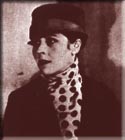
|
| Djuna
Barnes was born June 12, 1892, in Cornwall-on-Hudson, New York on her
family's farm. Through her father and grandmother, Barnes gained a great
appreciation of and dedication to the arts (the Barnes home was often
frequented by such artistic greats as Jack London and Franz Liszt). Barnes did not have a formal education because her father believed that the public school system was inadequate, and thus felt he felt that home schooling was much more beneficial. Her only formal schooling came after she left the home and moved to New York City. In 1912 Barnes enrolled as a student at Pratt Institute (1912-13) and the Art Students League (1915-16). While at Pratt, she began her writing career as a reporter and illustrator for the Brooklyn Eagle. Barnes wrote mostly feature articles and interviews. Douglas Messerli wrote in his foreword to I Could Never be Lonely without a Husband, Interviews by Djuna Barnes, "The more I worked with [the interviews], the more I came to understand these pieces less as standard journalism than as fascinating experiments in the impressionistic characterization that Barnes would perfect in her novels and poetry". This is illustrated by Barnes' choice of titles for her interviews, such as "Interviewing Arthur Voegtlin is Something Like Having a Nightmare," "Nothing Amuses Coco Chanel After Midnight," etc. Barnes' first published her poetry in 1915 as a collection of "rhythms and drawings" entitled The Book of Repulsive Women; four years later three of her plays were produced by the Provincetown Players. In 1923, Barnes published a collection of lyrical poems, stories, drawings, and one-act plays which she entitled A Book. The publisher of A Book described it as "... a chant which could be sung by those who are in the daily procession through the streets and highways of our metropolis but which could also be sung by those who are on balconies and house-tops viewing the eternal show of daily life." In 1921, Barnes was sent to Paris by McCall's as a correspondant and wrote articles for such magazines as Vanity Fair, Charm, and The New Yorker; she stayed for almost twenty years. While in France, she was heavily immersed in the modernist scene in Paris where she befriended such beneficial patrons as Natalie Barney and Peggy Guggenheim. This circle of women, which included wwriters such as Mina Loy, Janet Flanner, Dolly Wilde, and Gertrude Stein, became known as 'The Academy of Women.' (These days they are reffered to as "The Literary Women of the Left Bank.") Barnes wrote a satirical work, Ladies Almanack, about this salon and the women who were a part of it. Her second novel, Nightwood (1936), is her masterpiece of which * "T.S. Eliot wrote 'It is so good a novel that only sensibilities trained on poetry can wholly appreciate it.' In fact, it is often analyzed against the conventions of an extended poem rather than a short novel. However, the one thing which critics are not divided upon is the large sphere of influence that Barnes had upon other writers of her era. She is often compared to Joyce, Pynchon and Nathaniel West and the circle of her influence reaches out to include Truman Capote, William Goyen, Isak Dinesen, John Hawkes, and Anais Nin. Along with Nathaniel West she has been identified as one of the originators of Black Comedy and as Donald J. Greiner writes, it "...stands out among post-World War I American novels as one of the first notable experiments with a type of comedy that makes the reader want to lean forward and laugh with terror" (p.54)." Barnes also wrote a verse drama, The Antiphon (1958). When she returned to the United States, she wrote little and lived a reclusive life in her apartment on Patchin Place in Greenwich Village, where she died in 1982. Creatures in an Alphabet (1982), a small book of alphabet rhymes for adults, and Smoke, and Other Early Stories (1982) were published posthumously. |
|
*quote
cited from an article written by: Betsy Johnson, Karin Satrom, Ryan
McGee & Danielle Tarris, from the site "Women of the Left Bank"
|
|
Return to Top |